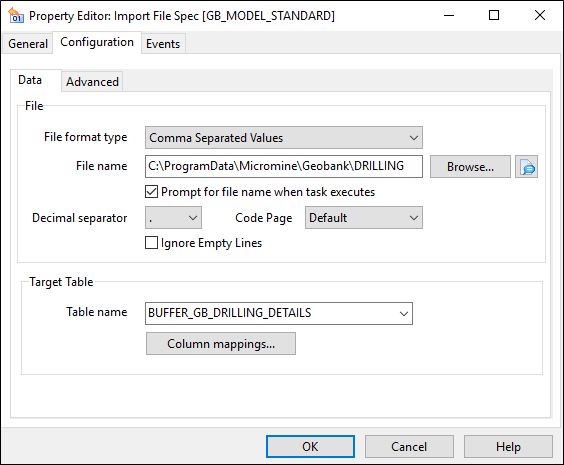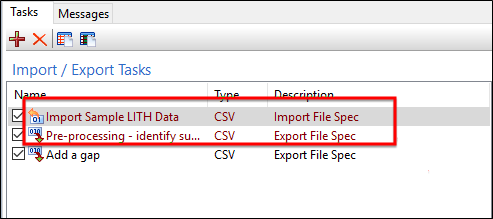Import File Specification: Configuration
Use the Configuration tab of the Import File Spec Property Editor to create a file specification that can be used to import data.

File
Format type
Select a (Comma Separated Values (CSV), Tab Delimited, Free Format, Fixed Format Text, Micromine Data File) input file format.
File name
Click the Browse button to navigate to the location of the Input file. You can File Name Substitutions when specifying the file name.
In order for the column mappings to work (see below) you will need to specify a valid file name. Once column mapping is complete, a substitution parameter can be specified in place of the temporary file name.
Prompt for file name when the task executes
Select this option to prompt for the file name when the Import task is run.
Decimal Separator
If the source language of the input file is not English, It may be necessary to change the default decimal separator to a comma.
Code page
If the source language of the input file is not English, It may be necessary to change the default code page. OEM866 is a code page used under DOS and OS/2 to write Cyrillic script.
Ignore empty lines
If blocks of data in the file are delimited by blank lines, you can choose to ignore them.
Target Table
Use the drop-down list to select the table that the data will be imported into. In order to import into the table, you will need to set up the Import File Specification: Columns between the fields in the file and the fields in the database.
Advanced
On the Advanced tab of the Property Editor, specify whether the completion of the import of the tasks in the file specification are mandatory or not.
Each task has three possible states:
|
Advanced Setting |
Meaning | Description |
|---|---|---|
|
Export process has to be completed to continue = True |
Required |
You must import/export the task to continue. The task is shown in red alongside a checked check box. The check box cannot be unchecked. |
|
Inactive at runtime = False |
Recommended |
It is recommended that you import/export the task before continuing. The task is shown alongside a check box which is checked by default, however the check box can be unchecked. |
|
Inactive at runtime = True |
Optional |
It is optional that the task be imported/exported. The task is shown alongside a check box which is unchecked by default. The check box can be checked. |
In this example, two tasks are shown as Required, while the third task is Recommended:

Multiple import/export file specifications can be combined in a single process. If the Import process has to be completed to continue check box is selected, the import process (as a whole) will be aborted if this file specification fails to complete.

Record Count
Choose whether to export all records or a specified number of records from the database.
Commit
For very large imports you may prefer to commit incrementally after a specified number of records have been processed. Otherwise, choose to commit once the import process is complete.
Archive Settings
To keep track of what data has been imported, you can choose to store your processed files in a nominated archive folder. If the same files are likely to be imported more than once, or the names of your files are not guaranteed to be unique, it may be useful to add a unique prefix to the files that are added to the archive.
Once files have been archived, you have the option of deleting them.